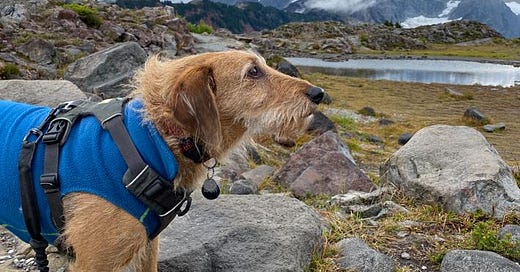Rewards can be extremely useful in training our dogs. They are a great way to communicate “I like this behaviour you just did, do more of that”.
Rewards are such a powerful tool, we need to understand what they are and how we can best use them to teach our dogs and build a strong relationship with them.
What is a reward?
A reward, as used in positive reinforcement dog training, is something you give your dog right after they do a certain behaviour, to increase the frequency of that behaviour. For example your dog sits, you give them a treat so they’ll sit more often.
Your dog decides what constitutes a reward, not you. While we often think of rewards as treats in dog training, rewards can be anything your dog finds valuable: food, toys, freedom of movement…
Even if you only look at food as a reward, different foods will have different values for your dog. Some love carrot and apple peels, some don’t. Some will happily work for their kibble, others not so much.
The value of a reward also changes with the environment and other factors. My dog loves a good petting session. While this is a great reward for staying calm and quiet at home, he’s not interested in a belly rub when we’re hiking in the mountains. Stopping more than a few seconds on trail is more of a punishment. On trail, high-value treats, the permission to stop and smell the ground, moving forward, and the ability to walk off leash are the highest possible rewards for my dog.
What are the best rewards for my dog?
To answer that question, you will need to observe and experiment.
What does your dog value?
Think of everything your dog likes: things that they would seek out themselves, food that they most like to eat, behaviours they enjoy doing… If you feel like it, make a list and assign a value to each reward, according to how much your dog enjoys it.
Here are some examples:
Eating food
Kibble
Treats
Carrots,
Apples
Pieces of meat
Pizza crust left on the sidewalk
Bully sticks
Raw bones
Your attention
Verbal praise
Petting
Belly rub
Play
Toys
Fetch
Tug
Social interactions
Greeting dogs
Moving forward on leash
Meeting new people
Chasing squirrels
Freedom of movement
Being off leash
Stopping to sniff a tree
Rolling in dead fish
Jumping on the couch
Going outside
Choosing what direction to take on a walk
What do you value?
If you look at the list, I’m sure you’ll find a few ‘rewards’ you don’t want to encourage. I can think of a few I’d like to cross off the list.
What rewards are practical to use when training?
When you are training at home as part of your daily routine or going to obedience classes, some rewards are more practical than others.
The reward should be of high enough value that it does the job of reinforcing the behaviour. Some foods might have such a high value that they are not practical to use when training because your dog becomes obsessed with it and cannot focus on the work. Through experimentation you’ll find the right balance.
Some rewards take too long to ‘consume’ (e.g. a bully stick or playing with other dogs) and are not practical during training sessions where you want to go through several repetitions.
How do you use rewards?
Timing is key!
When used immediately after a behaviour occurs (eg: dog sits, TREAT), a reward will increase the chance that the dog will perform that behaviour. If the delivery of the reward is not timely enough, you run the risk of unintentionally reinforcing behaviours you don’t like (e.g. dog sits, you fumble with your treat, by the time you give the treat the dog has started chewing on your shoe lace).
To help with timing you can use a word (YES!) or a clicker to mark the ‘correct’ behaviour and then immediately give a reward afterwards.
As discussed in the previous section, choose the right rewards for the current situation.
Vary your rewards! If the rewards become too predictable (like a vending machine containing only kibble) your dog might become less engaged over time, compared to a more unpredictable pattern of rewards (like a slot machine where you win something every time, but you’re not sure what).
Using rewards efficiently is a skill! This means it requires practice and you can expect to make mistakes. That’s okay! Be kind to yourself as you learn and don’t be afraid to work with a trainer who holds a similar philosophy as you do in terms of dog training. Like any area in life, there is nothing wrong with asking for help.




